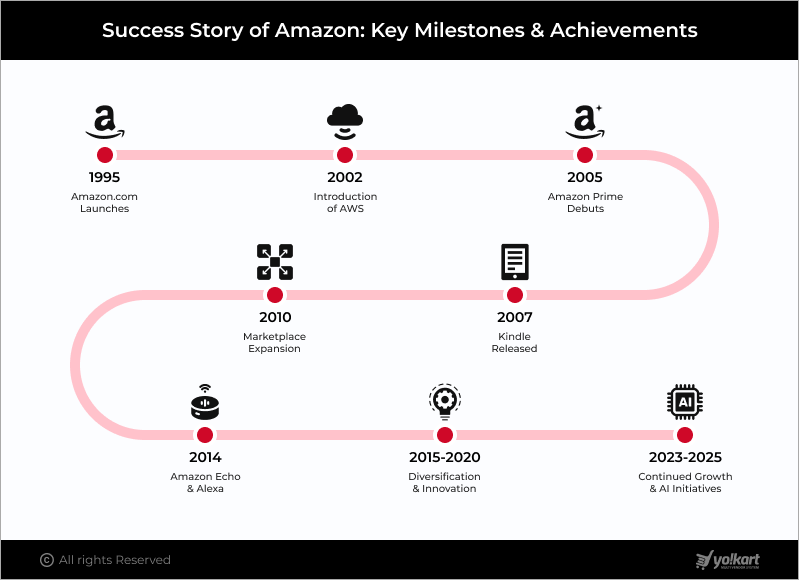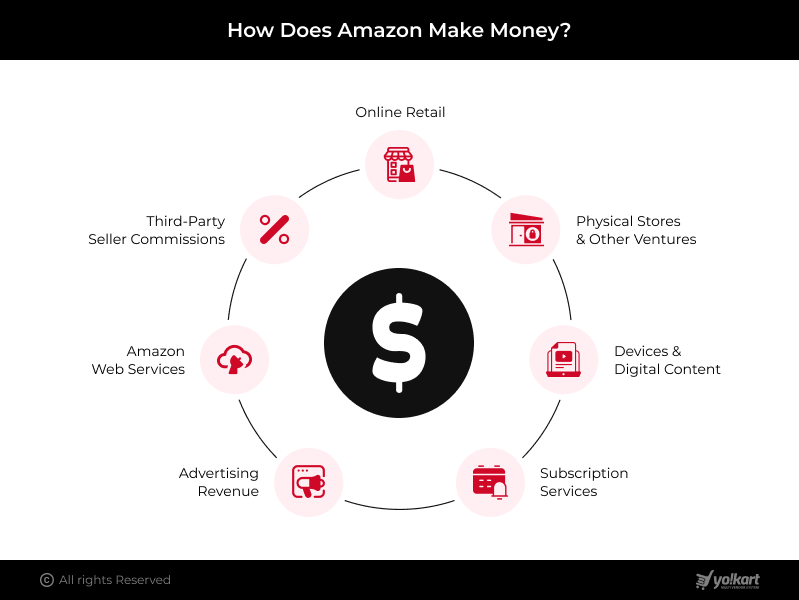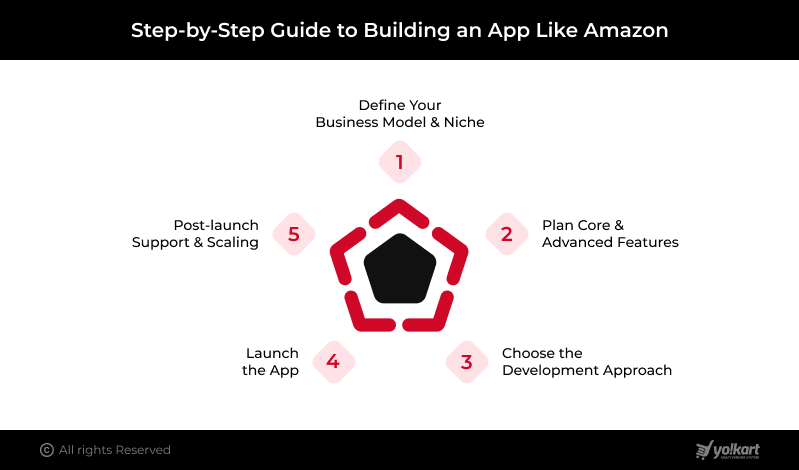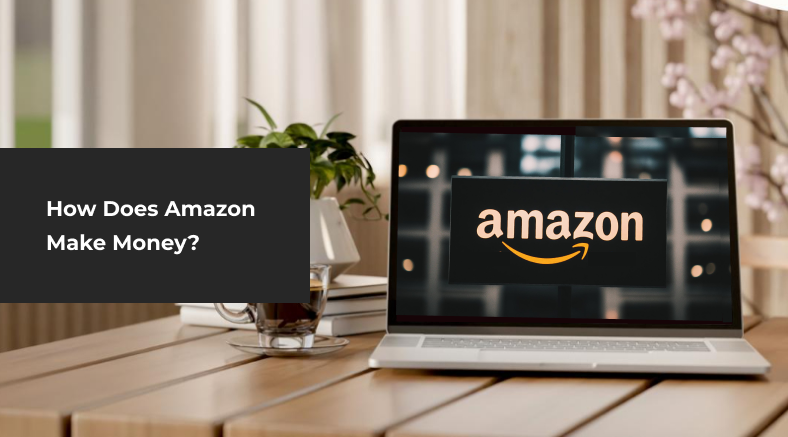Published Date 13 Nov 2025
Amazon has revolutionized the world of online retail, transforming from a humble online bookstore in 1994 into a global giant. Today, it is synonymous with convenience, fast delivery, and an unmatched customer experience. From retail to cloud computing and streaming, Amazon has reshaped how consumers and businesses connect online.
Its innovative business strategies, diversified revenue streams, and relentless focus on customer satisfaction have made it one of the most profitable and influential companies worldwide.
Thus, understanding how Amazon makes money offers valuable lessons for entrepreneurs aiming to launch their own eCommerce ventures. In this blog, you will dive deep into Amazon’s revenue model, highlight the essential features of a marketplace app like Amazon, and get to know how to build a scalable, feature-rich platform that can replicate its success in the digital marketplace.
Table of Contents
- Amazon at a Glance: Key Stats and Insights
- From 1994 to Today: Success Story of Amazon
- How Does Amazon Make Money? (Business/Revenue Model)
- How Can You Build a Platform Like Amazon?
- Necessary Features to Have in a Platform Like Amazon
- Step-by-Step Guide to Building an App Like Amazon
- How Yo!Kart Can Help You Build an App Like Amazon?
- Yo!Kart in Action: Inspiring Marketplace Success Stories
- Conclusion
- FAQs
Amazon at a Glance: Key Stats and Insights
Amazon has evolved into a global eCommerce and technology powerhouse, operating in over 190 countries and serving hundreds of millions of customers worldwide. The platform also partners with millions of third‑party sellers. According to the Q3 2025 earnings release of Amazon.com, Inc., the trailing twelve-month (TTM) net sales as of September 30, 2025, amounted to $691.33 billion.
Quick Snapshot:
- Prime membership (U.S. alone): ~180 million+ members.
- U.S. – market share: ~37.6 %.
- Amazon Web Services (AWS) revenue in 2024: ~USD 107.6 billion (≈19 % growth).
- Advertising growth: +18 % year‑over‑year in Q4 2024 to ~USD 17.3 billion.
These figures illustrate the scale and diversity of Amazon’s operations, from retail to cloud computing, subscriptions, and digital advertising, reinforcing why its business model serves as a blueprint for marketplace innovation.
From 1994 to Today: Success Story of Amazon
Founded by Jeff Bezos in 1994 as an online bookstore, Amazon has grown from a modest online bookstore to a trillion-dollar enterprise, driven by innovation, customer obsession, and strategic diversification. Its journey illustrates how technology, logistics, and a relentless focus on customer experience can redefine entire industries.
Key Milestones & Achievements:

- 1995: Launch of Amazon.com as an online bookstore, quickly expanding its catalog to music, electronics, and more, setting the stage for a full-fledged empire.
- 2002: Introduction of Amazon Web Services (AWS), providing cloud computing solutions that transformed the tech industry and became a major revenue driver for the company.
- 2005: Launch of Amazon Prime, initially focused on fast shipping, later evolving to include video streaming, music, and exclusive deals, greatly enhancing customer loyalty.
- 2007: Release of the Kindle eReader, revolutionizing digital reading and establishing Amazon as a leader in both hardware and digital content.
- 2010: Marketplace expansion enabled millions of third-party sellers to reach global customers, significantly increasing product variety and reinforcing Amazon’s position as a retail giant.
- 2014: Launch of Amazon Echo and Alexa, marking Amazon’s entry into voice-activated smart devices and AI-driven home automation.
- 2015-2020: Aggressive diversification into streaming services (Prime Video), AI and machine learning-powered recommendations, and advanced logistics networks, reinforcing Amazon’s tech-forward approach.
- 2023-2025: Continued growth in AWS, advertising, and AI initiatives, solidifying Amazon’s dominance across multiple sectors while innovating in new areas like AI-driven shopping experiences and generative AI applications.
Amazon’s long-term success stems from its ability to combine relentless customer obsession with bold innovation and diversification across eCommerce, cloud computing, AI, streaming, and smart devices, setting benchmarks that competitors strive to match.
How Does Amazon Make Money? (Business/Revenue Model)
Amazon’s revenue model is a classic example of diversification, leveraging multiple income streams beyond traditional eCommerce. By integrating retail, technology, subscriptions, and advertising, Amazon creates a robust ecosystem that maximizes customer engagement, retention, and lifetime value.

Its key revenue streams include:
- Online Retail (First-Party Sales):
Amazon earns by selling products directly to customers, including electronics, apparel, home goods, and more.
- Third-Party Seller Commissions & Fulfillment (FBA):
Millions of marketplace sellers pay fees for listing products and optional fulfillment by Amazon services, including storage, packaging, and shipping.
- Amazon Web Services (AWS):
Cloud computing, data storage, AI services, and enterprise solutions generate high-margin revenue, contributing significantly to Amazon’s profitability.
Notable Clients: Netflix, NASA, startups, and enterprises.
- Advertising Revenue:
Sponsored listings, display ads, and brand campaigns on Amazon’s platform drive a growing advertising business.
- Subscription Services:
Amazon Prime memberships, Kindle Unlimited, Audible, and other subscription programs offer recurring revenue while enhancing customer loyalty.
- Devices & Digital Content:
Amazon’s hardware lineup includes Kindle, Echo, Fire TV, and Alexa-enabled devices. These devices not only generate direct sales revenue but also drive digital content consumption through Prime Video, Audible, and eBooks, deepening customer loyalty and retention.
- Physical Stores & Other Ventures:
Amazon’s physical outlets like Whole Foods, Amazon Fresh, and Amazon Go blend digital convenience with in-person shopping, enhancing its omnichannel retail strategy. Beyond retail, ventures such as Zoox (autonomous vehicles) and Amazon Pharmacy expand their reach into mobility and healthcare, diversifying long-term growth avenues.
Breakdown of Amazon’s Profit Model
Amazon earns profits by combining high-volume, low-margin retail with high-margin services like AWS and advertising. This mix creates a balanced revenue model that cushions the company against economic fluctuations.
Additionally, its flywheel effect, more sellers bring better prices, attracting more buyers, which in turn attracts more sellers drives continuous growth and market dominance.

Key Points:
- High-volume retail + high-margin AWS & ads = profit balance
- Diversification protects against economic downturns
- The flywheel effect accelerates growth and market reach
Amazon’s Growth Strategy
Amazon’s growth is driven by a relentless focus on customer obsession and innovation. Moreover, the company continually reinvests profits into new technologies and global expansion, strengthening its market position.
Additionally, emerging areas such as AI, logistics automation, and drone delivery are set to fuel its next phase of growth, ensuring efficiency, faster service, and long-term competitiveness.
Key Points:
- Continuous reinvestment in technology and global expansion
- AI, logistics automation, and drone delivery as future growth drivers
- Customer-centric innovation fuels market leadership
Ecosystem Advantage: Each revenue stream reinforces the others. For example, AWS powers the platform, Prime drives engagement, and devices promote subscriptions, creating a self-sustaining ecosystem that increases customer lifetime value.
Learn How to Replicate Amazon’s Success for Your Marketplace
How Can You Build a Platform Like Amazon?
Amazon’s unparalleled success provides a proven blueprint for aspiring entrepreneurs looking to tap into this rapidly growing eCommerce market. Building an app like Amazon is a lucrative opportunity, as online retail shows no signs of slowing down.
However, to succeed in creating a marketplace that competes with industry giants, your app must prioritize three core principles: scalability, security, and user experience. Scalability ensures the app can grow with your customer base, security protects sensitive data and transactions, while a smooth, intuitive user interface (UI) guarantees a frictionless experience for both vendors and consumers.
Thus, to build an Amazon-like app, you have two primary development approaches:
- Custom Development: Developing an app from scratch allows you to build a platform that perfectly aligns with your business goals. You gain complete control over design, functionality, and integrations. While this approach delivers maximum flexibility, it requires a higher budget and a longer development timeline, typically several months to over a year. Additionally, the cost of building an Amazon-like app using this approach is very high.
- Ready-Made Multi-Vendor Solutions: Pre-built solutions offer a fast, cost-effective route to launch your Amazon-like marketplace. These platforms come with essential modules like vendor management, product catalogs, secure payment gateways, order tracking, and more. Most also provide scalability options, allowing you to add advanced features or expand into new markets without rebuilding the platform from scratch.
Hence, by carefully selecting the right development path and focusing on user experience, security, and scalability, entrepreneurs can create a feature-packed marketplace app capable of competing with established giants like Amazon.
Necessary Features to Have in a Platform Like Amazon
To replicate Amazon’s success, your eCommerce platform must offer a rich and diverse set of features. Below, we categorized the essential features into four key areas: User-Focused, Vendor-Focused, Admin-Focused, and Advanced Features. Let’s have a look at them:
Customer-Focused Features
- User Registration and Profile Management: Enable users to create and manage personalized accounts. Profile features should include saved preferences, order history, and payment methods for faster checkouts.
- Product Search, Filters, and Recommendations: Implement advanced search functionality with filters to help users find products quickly. Additionally, provide personalized product recommendations based on browsing behavior and past purchases.
- Shopping Cart and Checkout: Offer a user-friendly shopping cart with an option to save items for later. The checkout process should be seamless, with support for multiple payment methods, including credit/debit cards, digital wallets, net banking, and more.
- Order Tracking and History: Allow customers to track their orders in real-time and view their order history. Other than that, push notifications can update customers on the status of their orders (shipped, in transit, etc.).
- Multiple Payment Gateways: Integrate various payment gateways like PayPal, credit cards, Apple Pay, and other region-specific options to cater to a global audience.
Vendor-Focused Features
- Vendor Onboarding and Dashboard: Create an intuitive onboarding process for new vendors to list their products. Vendors should have access to a personalized dashboard where they can manage their store, products, and orders.
- Inventory and Order Management: Vendors should be able to efficiently manage their product inventory, including adding, updating, and removing products. Real-time updates on stock levels and order fulfillment are crucial for smooth operations.
- Commission Tracking and Analytics: Provide vendors with tools to track sales, commissions, and earnings. Analytics dashboards should offer insights into product performance, customer behavior, and sales trends to help vendors make data-driven decisions.
- Discount and Promotions Management: Allow vendors to create and manage their own discount codes, seasonal promotions, or special offers. This feature helps sellers drive sales and attract new customers, much like the flash sales and promotions Amazon frequently runs.
- Customer Interaction and Feedback Management: Provide vendors with the ability to interact with customers directly through messaging features, address queries, and respond to reviews or feedback. This encourages customer trust and fosters a sense of community around the vendor’s products.
Admin-Focused Features
- Centralized Control Panel: Admins should have a unified dashboard to monitor all aspects of the platform, including user accounts, vendor activities, transactions, and inventory management.
- User and Vendor Management: Admins must be able to manage user profiles and vendor accounts, including approving new sellers, monitoring activity, and handling disputes or issues.
- Reports and Insights: Generate comprehensive reports on sales performance, traffic data, user activity, and financials. These insights help in making informed decisions for growth and optimization.
- Commission Management: Commission management enables admins to set and track vendor commission rates, ensuring accurate payout calculations. It automatically handles commission deductions from sales, adjusts for refunds or cancellations, and generates detailed reports for transparency and financial oversight.
- Abandoned Cart: This feature allows admins to track and generate reports on items left in carts or removed by users. This data helps strategize recovery efforts by sending discount offers, reminders, or targeted marketing. It increases conversions by encouraging users to complete purchases and optimizes product listings based on insights.
Advanced Features
- AI-Based Product Recommendations: Implement AI-driven algorithms that suggest products to users based on their browsing history, preferences, and purchasing behavior, much like Amazon’s “You might also like” feature.
- Voice Search (Alexa-like Integration): Integrate voice search capabilities to allow users to find products hands-free, creating a more accessible and engaging shopping experience.
- Push Notifications and Personalized Offers: Send personalized notifications about new products, discounts, and exclusive offers to keep users engaged and encourage repeat purchases.
- Multi-Currency and Multi-Language Support: To cater to a global audience, your platform should support multiple currencies and languages. This ensures a seamless experience for customers from different regions and boosts international sales.
- Loyalty Programs and Prime-Like Memberships: Implement loyalty programs that reward repeat customers. Consider offering premium memberships with benefits like free shipping, exclusive deals, or early access to sales, similar to Amazon Prime.
Incorporating the right set of features is essential to create a competitive and user-friendly platform like Amazon. However, now that we’ve covered the key features, let’s move on to a detailed step-by-step guide to building an app like Amazon to help you navigate the development process effectively.
Create a Feature-Packed eCommerce Marketplace Today
Step-by-Step Guide to Building an App Like Amazon
Building an app like Amazon is a strategic, multi-phase process that requires careful planning, execution, and marketing. Henceforth, this step-by-step guide will help you understand each stage of development, from defining your business model to launching your app and scaling your marketplace.

1. Define Your Business Model and Niche
The first step is to establish a clear business model that aligns with your goals, target audience, and marketplace type. Therefore, you must decide:
- Marketplace Type:
- B2C (Business to Consumer): A platform where businesses sell products directly to consumers (Amazon’s core model).
- B2B (Business to Business): A platform where businesses sell products to other businesses, often in bulk (ideal for wholesale products).
- Hybrid Model: A combination of both B2B and B2C to cater to a broader audience.
- Identify Your Target Audience:
Understand your potential customers’ demographics, buying habits, and product preferences. Determine whether you’re targeting a specific niche or a broad consumer base.
2. Plan Core and Advanced Features
Once you’ve defined your business model, plan out both core and advanced features for your marketplace app. These features will be critical in driving user engagement, satisfaction, and retention. It should include:
- User Registration & Profile Management
- Advanced Product Search & Filters
- Personalized Product Recommendations
- Shopping Cart & Secure Checkout
- Order Tracking & History
- Multiple Payment Options (Wallet, Credit/Debit, EMI)
- Vendor Dashboard & Inventory Management
- Admin Control Panel & User Management
- Advanced Search with Voice Integration (Alexa-like)
- Push Notifications & Personalized Offers
3. Choose the Development Approach
When it comes to building an app like Amazon, you have two primary development paths: custom development or using a ready-made platform. Each has its pros and cons, depending on your budget, time, and specific requirements.
Custom Development:
| Pros | Cons |
| Total flexibility to design unique features. | High initial development cost. |
| Full control over branding, UX/UI, and customization. | Longer development timelines (6-12 months). |
| Tailored to specific business needs and scalability. | Requires dedicated technical resources. |
Readymade Solutions:
| Pros | Cons |
| Faster time-to-market (4-12 weeks). | Pre-selected tech stack provided by the solution provider |
| Lower initial cost. | – |
| Scalable and customizable. | – |
Recommendation: If you need a fast and cost-effective solution to get started, a white-label software can be a great option.
4. Launch the App
Once your app is ready, shift focus to a successful launch and user acquisition. Start creating buzz before the launch with pre-launch email campaigns, social media teasers, and influencer partnerships. Optimize your platform for SEO to attract organic traffic and ensure visibility. During the launch, leverage paid advertising and offer incentives to vendors to onboard early. Post-launch, maintain momentum with targeted marketing campaigns, loyalty programs, and seasonal promotions to retain users, encourage repeat purchases, and continuously grow your platform.
5. Post-launch Support and Scaling
After launching your app, focus on sustaining growth through key post-launch strategies. Providing excellent customer support via live chat, phone, or AI-powered chatbots helps ensure user satisfaction. Regular updates with new features, bug fixes, and performance optimizations are vital for maintaining a smooth user experience. Ensuring scalability through cloud services like AWS or Google Cloud will help your platform handle increased traffic as it grows. Lastly, actively collecting user feedback allows you to refine features, improve the overall user experience, and stay competitive in the market.
How Yo!Kart Can Help You Build an App Like Amazon?
Yo!Kart is a ready-made, multi-vendor eCommerce solution built to help entrepreneurs and enterprises create online marketplaces like Amazon with ease. Designed for
Yo!Kart
scalability, flexibility, and high performance, Yo!Kart enables you to launch a feature-rich marketplace without starting from scratch. It comes equipped with pre-integrated marketplace tools such as vendor dashboards, inventory management, and real-time analytics to streamline operations from day one. As a fully customizable and white-label solution, Yo!Kart allows you to maintain complete brand control while adapting the platform to your unique business needs. Backed by mobile apps for buyers and sellers, advanced security, and seamless automation, Yo!Kart is built to scale effortlessly as your marketplace grows.
Key Advantages of Yo!Kart
- Pre-integrated marketplace essentials: vendor dashboards, inventory, order management, and analytics.
- One-time payment, lifetime license: no recurring monthly or hidden fees.
- Fully customizable and white-label: complete control over design and branding.
- Mobile apps for buyers and sellers: ensuring seamless omnichannel accessibility.
- High scalability and enterprise-grade security: designed for long-term business growth.
- Live chat and customer support tools: for better engagement and faster resolution.
- Product comparison and multi-currency support: ideal for global marketplaces.
- Automated operations: streamlining workflows for vendors and admins.
- Built-in SEO, marketing, and reporting tools: to drive visibility and optimize performance.
- Multi-language and multi-payment gateway support: enhancing reach and flexibility.
Experience the Future of eCommerce with Yo!Kart
Yo!Kart in Action: Inspiring Marketplace Success Stories
Several entrepreneurs and businesses have leveraged Yo!Kart to create feature-rich, multi-vendor marketplaces. Here are some notable examples:
1. Tajer – Qatar’s Multi‑Category Marketplace
Tajer is a value‑driven marketplace in Qatar that connects consumers with premium local and global brands across fashion, beauty, home & living, electronics, and more. Built with Yo!Kart, it features dynamic shipping logic, bilingual invoices (English/Arabic), and a mobile‑optimized front end that aligns with regional standards.
2. Jewora – India’s Artificial Jewellery Marketplace
Jewora is India’s dedicated multi‑vendor marketplace for artificial and imitation jewellery, offering thousands of designs (Kundan, Polki, American Diamond, Meenakari, and more). With Yo!Kart, as its foundation, shoppers enjoy secure checkout, pan‑India delivery, easy returns, and vendor tools, including analytics and brand stores.
3. Little Local – U.S. Hyper‑Local Marketplace
Little Local leverages Yo!Kart to connect consumers with neighborhood stores across the U.S., empowering small businesses while delivering same‑day pickup and next‑day shipping options. The platform’s vendor‑onboarding, commission management, and mobile‑app support enable a seamless local shopping experience.
4. My Valley – UK Eco‑Friendly Products Marketplace
My Valley is a UK‑based marketplace focusing on eco‑friendly products and sustainable brands. Built using Yo!Kart’s modular architecture, it offers multilingual support, multi‑currency pricing, vendor dashboards, and tailored reporting, designed to scale and support conscious‑consumer shopping.
Conclusion
Amazon’s success comes from innovation, customer focus, and diversified revenue streams, setting a standard for modern eCommerce. Its model shows how technology, data, and smart operations can create a seamless shopping experience that keeps customers coming back.
Aspiring entrepreneurs can replicate this model by leveraging scalable, modern multi-vendor platforms that provide the tools, flexibility, and technology needed to launch and grow a marketplace. Building an Amazon-like marketplace isn’t about size, but it’s about vision, technology, and customer experience.
FAQs
Q 1. What Is Amazon’s Main Business?
Ans. Amazon’s main business focuses on being a prominent online retailer/third-party marketplace and a top cloud computing provider. However, the bulk of its income comes from its eCommerce divisions, which provide a wide range of goods. Nonetheless, the company’s main source of operational revenue is the extremely lucrative Amazon Web Services (AWS) cloud division, which offers crucial infrastructure services to other companies.
Q 2. How Does Amazon Make Most of Its Money?
Ans. Amazon makes most of its money from the highly profitable cloud computing division, Amazon Web Services (AWS), which contributed 58% of its 2024 operating income. Although online retail generates the most revenue, the profit margins are significantly lower. Other income streams include third-party seller services, advertising, and Prime subscription fees, but AWS remains the primary profit engine.
Q 3. Does Amazon charge both sides of its marketplace?
Ans. Yes, Amazon charges both sides of its marketplace. From sellers, it charges referral/commission fees plus optional services like fulfillment and advertising. Similarly, it draws revenue from buyers through subscription services such as Prime and subscriptions for digital content. This two‑sided monetization broadens its revenue base and strengthens engagement.
Q 4. How does Amazon’s subscription model, beyond Prime, add to its revenue?
Ans. Beyond Prime, Amazon offers subscriptions like Audible, Kindle Unlimited, Amazon Music and other digital services. These recurring subscriptions generate consistent income, deepen customer loyalty, and increase lifetime value, while also embedding users into Amazon’s broader ecosystem of services.
Q 5. How can a multi-vendor marketplace generate revenue beyond product sales?
Ans. Beyond product sales, a marketplace can earn through:
- Commission on vendor sales
- Subscription plans
- Advertising
- Premium listings
- Value-added services (logistics, analytics, or marketing tools).
Diversifying revenue streams ensures steady income while enhancing vendor and customer engagement, making the platform sustainable and profitable.
Q 6. What strategies help attract and retain vendors on a new marketplace platform?
Ans. Strategies like offering easy onboarding, transparent commissions, marketing support, analytics tools, and prompt payments can help attract and retain vendors on the platform. Moreover, consistently improving platform features and engagement helps foster trust, ensuring a growing, loyal seller base.
Q 7. What features make a marketplace competitive in today’s eCommerce landscape?
Ans. A competitive marketplace today goes beyond standard features. Thus, by offering eco-friendly options, integrating community-building tools, social commerce, gamification, loyalty programs, localized experiences, and real-time customer support, help differentiate your platform, boost engagement, and foster long-term user loyalty.
Q 8. Can I customize a readymade solution to match my brand?
Ans. Yes, platforms like Yo!Kart is fully customizable and white-label, allowing businesses to adjust UI/UX, colors, logos, features, and workflows. This ensures your marketplace aligns with your brand identity while leveraging a ready-made, reliable infrastructure.
Q 9. How does Yo!Kart ensure scalability and performance for large marketplaces?
Ans. Yo!Kart is built with a scalable infrastructure and a modular architecture specifically designed for multi‑vendor marketplaces. The platform uses the LAMP stack and is designed for self‑hosting. Moreover, it allows marketplace owners full control over infrastructure and scaling, helping maintain high performance as operations expand.




